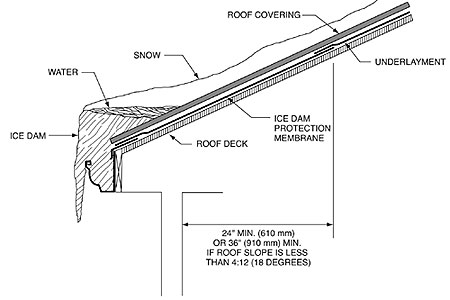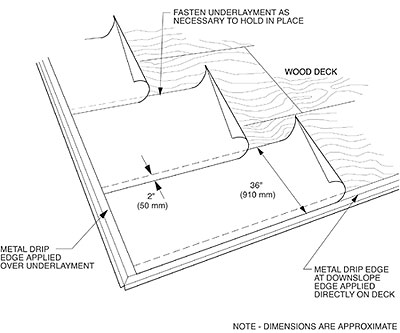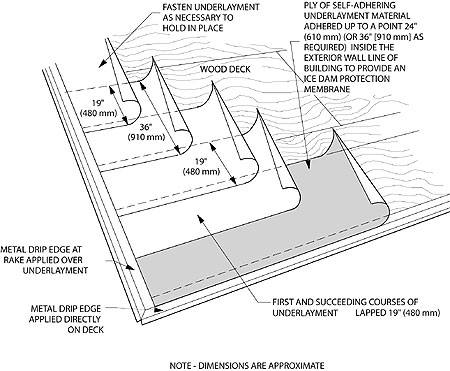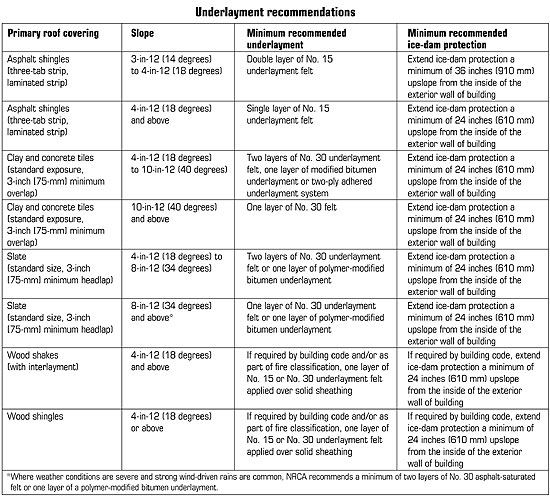Since 1981, The NRCA Roofing and Waterproofing Manual has contained underlayment recommendations in its steep-slope roofing section. Although these recommendations have evolved during the years, some basic design principles have remained the same. For instance, different steep-slope roof coverings require underlayments that correspond with a roof covering's anticipated service life and roof slope. Because of the many variations possible, I will discuss the function, design considerations and current NRCA recommendations for the use of underlayments with different steep-slope roof coverings.
The basics
Steep-slope roof systems are considered water-shedding. They typically are composed of individual pieces or components installed in shingle fashion. Water-shedding roof systems rely on gravity to shed water from one course to the next. Therefore, slope is an important consideration when choosing and installing a roof system underlayment.
NRCA recommends you use underlayments with every steep-slope covering. Underlayments are applied over roof decks or substrates before roof covering application and perform several primary functions. They provide weather protection for a limited time until a roof covering is installed; provide a secondary weatherproofing barrier if moisture bypasses the roof covering; and serve as a separator between the roof covering and substrate. Underlayments are not intended to be used as temporary weather protection.
Underlayments generally are necessary for several other significant reasons. First, they are required by building codes. Current editions of all model building codes, including the International Building Code (IBC) and National Fire Protection Association's NFPA 5000: Building Construction and Safety Code require underlayments. Also, underlayments need to be included in roof systems because most, if not all, fire-tested roof systems include underlayments as part of the Class A, Class B or Class C fire-rating classifications. Finally, underlayments typically are required to meet manufacturers' system or material warranties.
Materials
There are several varieties of underlayments available. The most familiar and commonly used is asphalt-saturated felt with an organic reinforcing mat. Underlayments are reinforced with mats that are designed to support the asphalt. Reinforcing mat types include organic, fiberglass, polyester, and a combination of organic and inorganic. For asphalt-saturated felt underlayments, there are three applicable ASTM International standards: ASTM D226-97a, "Standard Specification for Asphalt-Saturated Organic Felt Used in Roofing and Waterproofing"; ASTM D4869-03, "Standard Specification for Asphalt-Saturated Organic Felt Underlayment Used in Steep Slope Roofing"; and ASTM D6757-02 "Standard Specification for Inorganic Underlayment for Use with Steep Slope Roofing Products."
ASTM D4869-03 was revised to include nonperforated felt referred to in ASTM D226-97a. ASTM D226-97a eventually will be phased out as a reference standard for asphalt-saturated felt used as underlayments. ASTM D4869-03 and ASTM D6757-02 address material characteristics and physical properties. ASTM D4869-03 provides four classifications: Type I—#8 underlayment, Type II—#13 underlayment, Type III—#20 underlayment and Type IV—#26 underlayment. Types I and III represent products previously classified by ASTM D4869-93, Types I and II, respectively. Types II and IV represent products previously described as complying with ASTM D226-97a Type I (No. 15) and ASTM D226-97a Type II (No. 30), respectively.
Because underlayments are required by building codes, a specific advantage to having No. 15 and No. 30 underlayment products defined by ASTM D4869-03 is that the standard includes a liquid-water transmission test (shower test) for underlayments that ASTM D226-97a does not include. ASTM D4869-03 also includes dimensional stability limits to address wrinkling issues.
ASTM D6757-02 addresses requirements for fiberglass- or fiberglass-composite-reinforced underlayment products. The intent of ASTM D6757-02 is to provide criteria for the production and evaluation of underlayments that are less likely to wrinkle before and after installation of roof covering materials.
An additional product used as an underlayment is a self-adhering polymer-modified bitumen membrane. The polymers, which alter the bitumen chemically, provide enhanced weathering, aging and sealing characteristics. These materials are more resistant to wrinkling and distortion and exhibit better water-shedding properties than traditional asphalt-saturated felts. As a result, more of these underlayments are used on projects where enhanced underlayment performance is desired.
A special configuration of underlayments is an ice-dam protection membrane. This underlayment provides additional protection from moisture intrusion along roof eaves, in valleys where ice dams can occur, at elevation changes and around penetrations. An ice-dam protection membrane may consist of a single layer of self-adhering polymer-modified bitumen membrane or two plies of asphalt-saturated, nonperforated felt where the first ply is fastened to a roof deck or substrate and the second ply is adhered to the first with roof cement or cold adhesive. NRCA recommends self-adhering polymer-modified bitumen membrane sheets used as underlayments have minimum thicknesses of 40 mils (0.04 inches [1.1 mm]) and comply with ASTM D1970, "Standard Specification for Self-Adhering Polymer Modified Bituminous Sheet Materials Used as Steep Roofing Underlayment for Ice Dam Protection."
Another type of underlayment is a synthetic underlayment. Such products entered the market about 10 years ago and are characterized as being lightweight, water-resistant and less likely to wrinkle; having high tear strength; and being easy to walk on—even when wet. Theoretically, the products may be left exposed to the elements for extended periods of time. Most synthetic underlayments are available in wider rolls than conventional asphalt-saturated and -impregnated felts, resulting in labor savings.
Although synthetic underlayments and their purported attributes seem appealing, there are significant issues to consider before using them. To date, there are no applicable ASTM standards for these products. Many synthetic underlayments do not meet current building code requirements, so manufacturers need to obtain a code evaluation report for code compliance. And use of these underlayments may void some manufacturers' material warranties for certain roof coverings (such as with asphalt shingles).
Design considerations
When selecting the type of underlayment for use in a steep-slope roof system, consider the following issues:
- Service life: The underlayment should match the primary roof covering's anticipated service life. A heavier, more durable underlayment, such as a double-layer, No. 30 felt or modified bitumen sheet, should be used with more durable roof coverings, such as slate or tile. For roof coverings with shorter life spans, such as 20- or 25-year asphalt shingles, a less durable underlayment, such as No. 15 felt, may be appropriate.
- Slope: Steep-slope roof systems rely on slope to shed water. Therefore, the lower the slope, the more substantial the underlayment should be. For lower-slope systems, water won't shed as quickly off the roof, consequently increasing the chance of water infiltrating the primary roof covering layer. This situation necessitates a more enhanced water-shedding underlayment.
- Climate: In locations where the average January temperature is 30 F (-1 C) or less, NRCA recommends an ice-dam protection membrane be installed. An ice-dam protection membrane should be applied at a roof system's eaves and extend upslope a minimum of 24 inches (610 mm) from the inside of the exterior wall line of a building (see Figure 1). For slopes that are less than 4-in-12 (18 degrees), NRCA recommends an ice-dam protection membrane extend 36 inches (910 mm) minimum from the inside of the exterior wall. Ice-dam protection membranes also should be considered in valleys and at elevation changes and penetrations.

Figures courtesy of The NRCA Roofing and Waterproofing Manual, Fifth Edition.
Figure 1: This section shows ice-dam protection membrane recommendations.
Installation
Different underlayment configurations can be used, and generally, they are categorized as a single layer of underlayment; single layer of self-adhering underlayment; double layer of underlayment; and two-ply, adhered underlayment system.
A single layer of underlayment is one ply or sheet fastened to a roof deck before roof covering application. NRCA recommends underlayment sheets be installed horizontally in shingle fashion and lapped a minimum of 2 inches (51 mm). End laps should be a minimum of 4 inches (102 mm). Underlayment sheets should be fastened with nails or staples, as necessary, to hold the felts in place until installation of the primary roof covering (see Figure 2).

Figure 2: An example of a single layer of underlayment, a 36-inch- (910-mm-) wide sheet, without an ice-dam protection membrane
In certain geographic locations and under extenuating circumstances, an underlayment may be installed in vertical runs. This is referred to as "strapping." If strapping is used, NRCA recommends the sheets be offset at a slight angle to promote drainage. Side lap and end lap coverage should be increased, as well. Generally speaking, strapping should be limited to steeper slopes that are more difficult to cover with horizontal runs.
A single layer of self-adhering underlayment is one layer of self-adhering polymer-modified bitumen sheet membrane applied to a roof deck. This type of membrane is designed to be used as an ice-dam protection membrane and for projects where a higher degree of underlayment performance is desired. However, note when these types of membranes are installed over an entire roof area, they act as air retarders and vapor retarders. When a vapor retarder is installed over an entire steep-slope roof deck, ventilation, moisture control and proper vapor retarder placement (relative to the insulation) must be considered to avoid potential problems.
A double layer of underlayment is two layers of underlayment fastened to a roof deck before applying primary roof covering. All underlayment sheets should be installed horizontally in shingle fashion with one-half the roll width minus 1 inch (25 mm) minimum exposure and one-half the roll width plus 1 inch (25 mm) minimum underlap. For a 36-inch- (910-mm-) wide asphalt-saturated felt, there would be a 17-inch- (430-mm-) exposure and 19-inch- (480-mm-) underlap (see Figure 3).

Figure 3: An example of a double layer of underlayment, a 36-inch- (910-mm- ) wide sheet without an ice-dam protection membrane
A two-ply adhered underlayment system generally refers to two layers of underlayment adhered together with cold adhesive to form a continuous weatherproof membrane. The first layer is fastened to the deck, and the top layer is adhered to the first layer.
Figure 4 summarizes underlayment recommendations for various steep-slope roof coverings.

Figure 4: Underlayment recommendations for different roof coverings
Summing it up
When specifying steep-slope roof systems, match underlayments with a roof's slope and anticipated service life. In addition, climate, manufacturers' warranties, fire ratings and building codes should be addressed.
This article provides more current information than The NRCA Steep-slope Roofing Manual, Fifth Edition. However, the manual still should be referenced for other fundamental information.
Joan P. Crowe is an NRCA manager of technical services.

